#Anglican Diocese of Liverpool
Text
Anglican Cathedral Interior. Nikon F65. Expired Truprint 200 (shot at 800.)
One of the most striking buildings in this city is Liverpool Cathedral (known as The Anglican Cathedral to distinguish it from it's catholic counterpart that stands at the opposite end of Hope Street.) Despite being a non believer I do like walking past it and on occasion step inside.
When the photos came back one thing became clear. I really do need to make sure I hold my camera straight!










#liverpool#liverpoollomo#lomo#lomography#analogue photography#nikon f65#nikon slr#film slr#colour 35mm film#pushing film#exposure compensation#200 shoot at 800#expired film#liverpool cathedral#anglican cathedral#Anglican Diocese of Liverpool#cathedral#place of worship#film is not dead#don't think just shoot
2 notes
·
View notes
Text
Events 9.7 (after 1900)
1901 – The Boxer Rebellion in Qing dynasty (modern-day China) officially ends with the signing of the Boxer Protocol.
1906 – Alberto Santos-Dumont flies his 14-bis aircraft at Bagatelle, France successfully for the first time.
1907 – Cunard Line's RMS Lusitania sets sail on her maiden voyage from Liverpool, England, to New York City.
1911 – French poet Guillaume Apollinaire is arrested and put in jail on suspicion of stealing the Mona Lisa from the Louvre museum.
1916 – US federal employees win the right to Workers' compensation by Federal Employers Liability Act (39 Stat. 742; 5 U.S.C. 751)
1920 – Two newly purchased Savoia flying boats crash in the Swiss Alps en route to Finland where they were to serve with the Finnish Air Force, killing both crews.
1921 – In Atlantic City, New Jersey, the first Miss America Pageant, a two-day event, is held.
1921 – The Legion of Mary, the largest apostolic organization of lay people in the Catholic Church, is founded in Dublin, Ireland.
1923 – The International Criminal Police Organization (INTERPOL) is formed.
1927 – The first fully electronic television system is achieved by Philo Farnsworth.
1929 – Steamer Kuru capsizes and sinks on Lake Näsijärvi near Tampere in Finland. One hundred thirty-six lives are lost.
1932 – The Battle of Boquerón, the first major battle of the Chaco War, commences.
1936 – The last thylacine, a carnivorous marsupial named Benjamin, dies alone in its cage at the Hobart Zoo in Tasmania.
1940 – Romania returns Southern Dobruja to Bulgaria under the Treaty of Craiova.
1940 – World War II: The German Luftwaffe begins the Blitz, bombing London and other British cities for over 50 consecutive nights.
1942 – World War II: Japanese marines are forced to withdraw during the Battle of Milne Bay.
1943 – A fire at the Gulf Hotel in Houston kills 55 people.
1943 – World War II: The German 17th Army begins its evacuation of the Kuban bridgehead (Taman Peninsula) in southern Russia and moves across the Strait of Kerch to the Crimea.
1945 – World War II: Japanese forces on Wake Island, which they had held since December 1941, surrender to U.S. Marines.
1945 – The Berlin Victory Parade of 1945 is held.
1953 – Nikita Khrushchev is elected first secretary of the Communist Party of the Soviet Union.
1963 – The Pro Football Hall of Fame opens in Canton, Ohio with 17 charter members.
1965 – During an Indo-Pakistani War, China announces that it will reinforce its troops on the Indian border.
1965 – Vietnam War: In a follow-up to August's Operation Starlite, United States Marines and South Vietnamese forces initiate Operation Piranha on the Batangan Peninsula.
1970 – Fighting begins between Arab guerrillas and government forces in Jordan.
1970 – Vietnam Television was established.
1977 – The Torrijos–Carter Treaties between Panama and the United States on the status of the Panama Canal are signed. The United States agrees to transfer control of the canal to Panama at the end of the 20th century.
1979 – The Chrysler Corporation asks the United States government for US$1.5 billion to avoid bankruptcy.
1984 – An explosion on board a Maltese patrol boat disposing of illegal fireworks at sea off Gozo kills seven soldiers and policemen.
1986 – Desmond Tutu becomes the first black man to lead the Anglican Diocese of Cape Town.
1997 – Maiden flight of the Lockheed Martin F-22 Raptor.
2005 – Egypt holds its first-ever multi-party presidential election.
2008 – The United States government takes control of the two largest mortgage financing companies in the US, Fannie Mae and Freddie Mac.
2010 – A Chinese fishing trawler collides with two Japanese Coast Guard patrol boats in disputed waters near the Senkaku Islands.
2011 – The Lokomotiv Yaroslavl plane crash in Russia kills 43 people, including nearly the entire roster of the Lokomotiv Yaroslavl Kontinental Hockey League team.
2017 – The 8.2 Mw 2017 Chiapas earthquake strikes southern Mexico, killing at least 60 people.
2019 – Ukrainian filmmaker Oleg Sentsov and 66 others are released in a prisoner exchange between Ukraine and Russia.
0 notes
Text
Liverpool, February 4-8, 2020
Tuesday
Set off on a new adventure to Liverpool, intending to stop overnight in Stafford but we made such good progress that we decided to press on and give ourselves an extra day in Liverpool.
Arrived at the campsite in Southport about 4pm and were soon set up, and decided to treat ourselves to a meal out. Freezing cold by the seafront but we walked along to a pub where we had vouchers for a free drink each, The Guelder Rose. Had our drink and decided to have a carvery there as well, which was lovely. Called in to a couple more pubs on the way back to the van admiring the elegance of Southport, before a quick bit of tv and an early night.
Wednesday
Up to get the train into Liverpool. About a 40 minute journey in and when we arrived we headed straight for Mathew Street, home of the Cavern Club. Had a look at the wall of fame outside and the discs to commemorate every Number One hit by a Liverpool group or artist then went down into the depths of the Cavern Club for a drink and listen to a local musician. Loads of memorabilia around the walls and every inch of the brickwork has been signed by visitors.
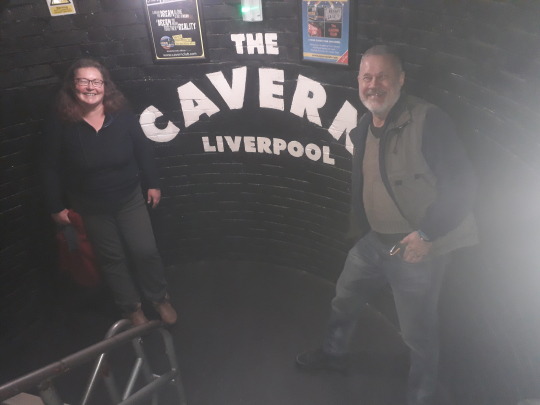
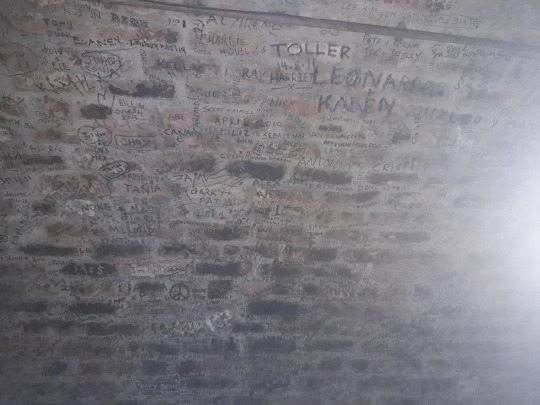

A lovely time looking round then we came out and headed for Albert Docks. It suddenly got really cold again so we went into the Maritime museum to warm up. Sadly, the Titanic display was closed for work to be done on it but we went round the Museum of slavery and the Lusitania exhibition. A huge place and loads of information. Had lunch in the café there, a bowl of Scouse, a lamb stew served with pickled red cabbage.


We then headed away from the water to Chinatown and the Anglican Cathedral, the biggest in Britain. We found the arch but considering it’s meant to be the largest Chinatown in the country, we couldn’t find much at all, a street of closed restaurants and that was about it.
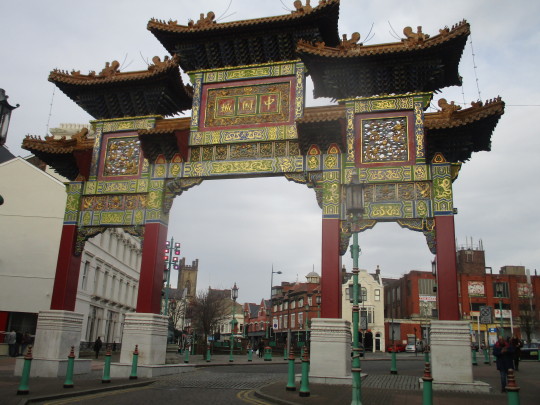
The cathedral was much more impressive, designed in 1902 by Giles Gilbert Scott whose other claim to fame is as the designer of the red phone box.

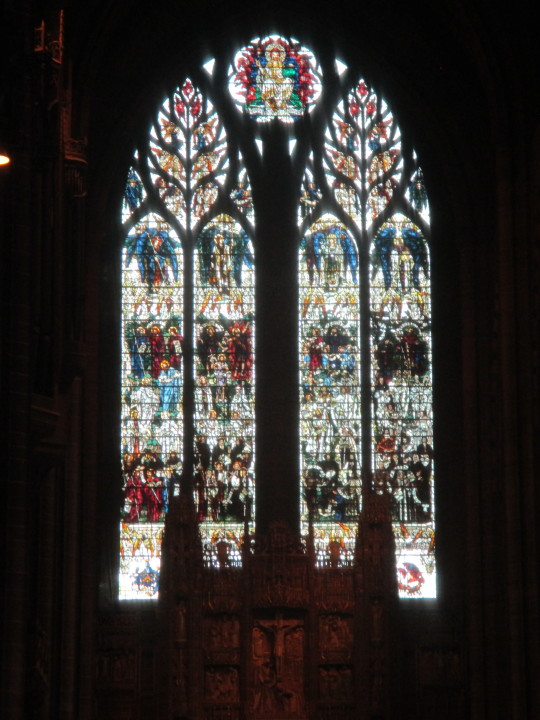
A wander back into the city, calling at the Bombed-Out Church, and a last drink to rest our weary legs before heading back on the train to Southport and back to the van.
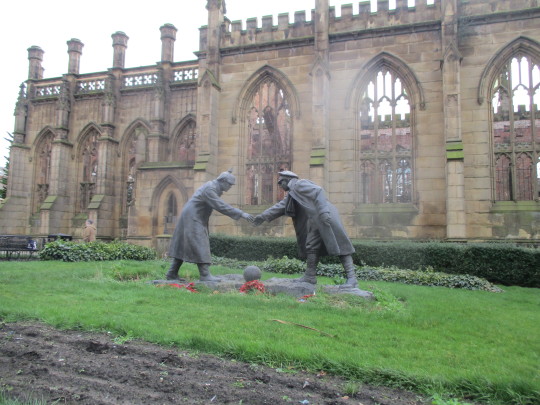
Thursday
Up in good time to catch the train into Liverpool and get to the Mersey Ferry for the 11am cruise. Just before embarking we strolled to The Beatles statue at the Pier Head and waited our turn for selfies with the Fab Four.
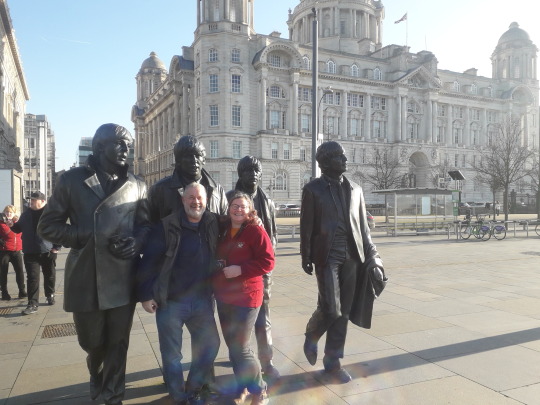
It was cold out on the river but the cruise was the best way possible to see Liverpool’s famous waterfront, including the Three Graces – the Liver building, the Cunard offices and the Port of Liverpool building. Spent about 45 minutes going across and up and down the river, with two stops on the Wirral. Every so often they played a little blast of Ferry Cross the Mersey, which was nice.
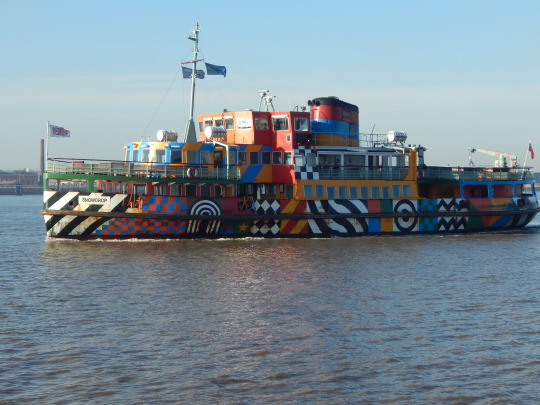
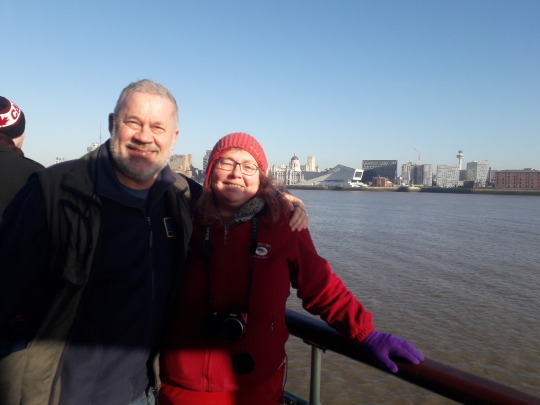
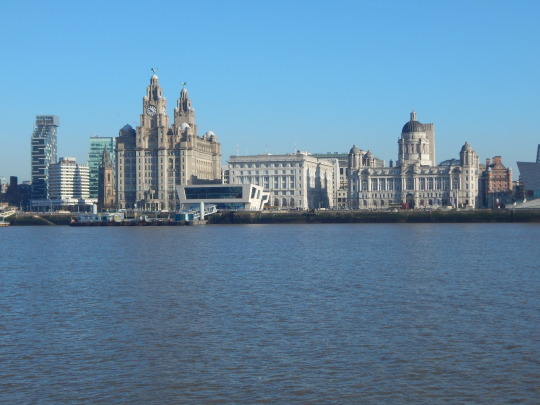
Disembarked and made our way back into town, looking around St Nick’s - the fishermen’s church totally rebuilt after all but the spire was destroyed in the war – before stopping off for the first drink of the day at the nearby Pig and Whistle pub. Took time out for a lovely and very filling Chinese buffet meal and then it was off to the Metropolitan cathedral – Paddy’s Wigwam – an absolutely incredible building.
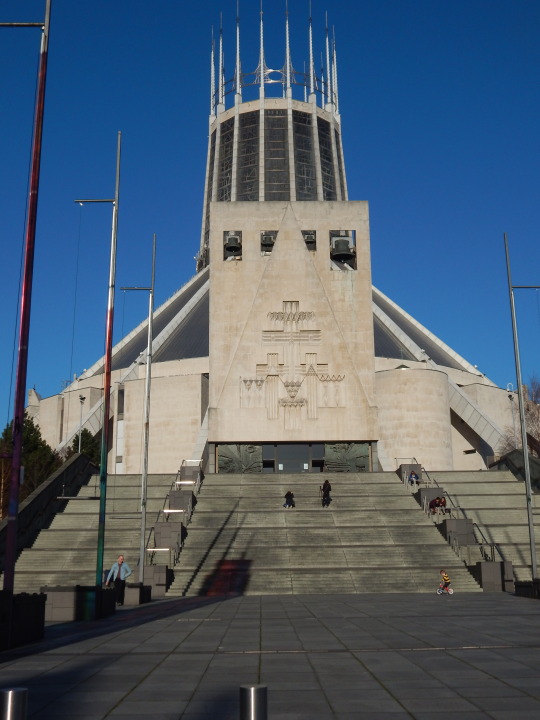

We were amazed to learn that the iconic structure was in fact the third design over many decades. The other two were never built, although the crypt for the second, giant dome design was constructed in the 1930s. It’s the biggest crypt in Britain and it sits underneath a cathedral of a totally different design! Walked all around the outside of the cathedral, looking at the different chapels on the way and seeing the inscribed name of Elizabeth’s grandad, who was the diocese surveyor. Walked on back into Liverpool, stopping at Ma Egerton’s pub, named after a famous theatrical agent and landlady before visiting the statue of Eleanor Rigby near Mathew Street before heading to the Cavern Pub for a drink. Home on the teatime train for cheese rolls, wine, a film, and a very resting bed!
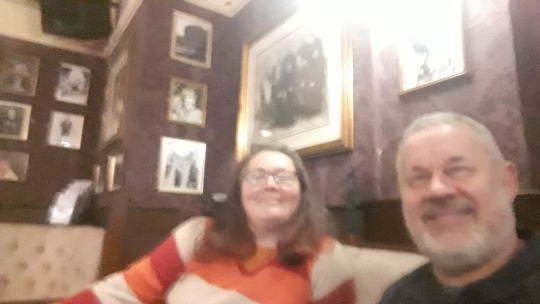
Friday
A well-deserved lie-in today after all our walking. Had a stroll into Southport and a look at the shops then treated ourselves to fish and chips in Spoons. Back to the van for a cup of tea and relax before setting off into Liverpool about 5pm.
Had a drink in The Grapes pub in Mathew Street and then we went to the Beatles show at the Cavern. It’s not in the actual cavern but an underground lounge next door, pretty packed with people of all ages. A good warm-up act of a bloke with a guitar covering lots of stuff by other performers at the Cavern over the years, from Buddy Holly to Queen, who had their first paid gig at the Cavern.


The Beatles came on later and ran through a host of songs with very little chat in between. Paul and John looked very like the originals but it was a good show, people were up and dancing and we left very reluctantly just before the end to catch the penultimate train back to Southport and finally rolled into bed about midnight, weary but happy.
Saturday
A bit of a lie in this morning before catching the train again, this time to head under the Mersey to the Wirral. A very easy transport system and regular trains meant we were soon at Rock Ferry, the nearest station to Prenton Park, the home of Tranmere Rovers.

A 20 minute walk got us to the ground and we picked up our tickets before joining a couple of coach loads of Pompey fans in the Prenton Park pub. We then wandered up to the ground where they have a fan zone, a big marquee outside the ground open to all fans. They have a bar, food, hot drinks, tables, an area for kids to play Fifa and lots of memorabilia. There were loads of families and fans meeting up there and it was a really friendly atmosphere. Probably the only time we will see a football marquee with chandeliers!
A few problems with seating as there were no set seats and the gangways soon filled up, not helped by the steward who just told them to squeeze in where they could! They were soon moved to the edges of the stand by the police and everything settled down to a good game on a pretty ropey pitch. A 2-0 win for Pompey helped us ignore the freezing cold wind and we made a detour on the way home to a pub that had the best toilets in Liverpool. The Philarmonic Dining Rooms pub, beautifully decorated with red marble urinals in the gents, (very ordinary ladies toilets), which is now a Grade 1 listed building.

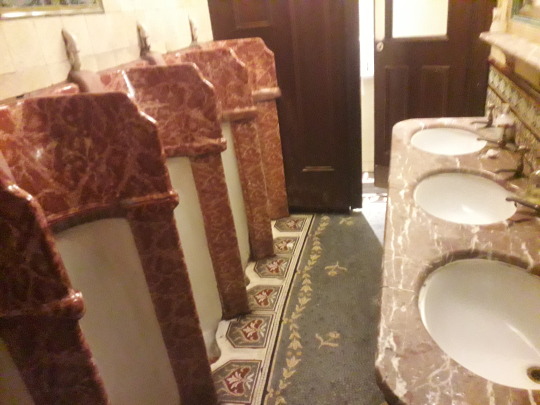
Back to Southport and a quick steak dinner before a good night’s sleep.
1 note
·
View note
Link
28th September >> (@romereports) #PopeFrancis #Pope Francis: Anglican bishop accompanies bishops of #England and #Wales in their ad limina visit.
Pope Francis had a meeting with the bishops from England and Wales during their ad limina visit at the Vatican. They have been here for a week to see the pope and the Vatican Curia, and to visit the tombs of SS. Peter and Paul.
They have talked to all the dicasteries in Rome about current issues and the work they are doing back in their country.
Among the Catholic bishops was also Church of England Bishop, Christopher Foster, who had this to say when meeting Pope Francis.
“I am very honored. Thank you for receiving me. We pray for each other and for all we share.”
According to the Archbishop of Liverpool, who participated in the ad limina visit, ecumenism plays an important part between the different Churches in England and can serve as an example for others.
MALCOLM MCMAHON
Archbishop of Liverpool
“We are very ahead in our understanding of ecumenical dialogue and the way in which it can enrich our Church, that is the message in which we have received from the Second Vatican Council and from the teachings of the popes since that time.”
Recently, the Bishops of England and Wales have asked the National Catholics Commission to carry out an entirely independent and comprehensive review of their safeguarding structures. This call comes after a report, last month, that condemned the handling of abuse cases by two of Britain’s top independent Catholic schools.
MALCOLM MCMAHON
Archbishop of Liverpool
“We really want to show that we are taking them very seriously by looking again at our structures, but not by ourselves...” “Independent, thoroughly independent inquiry into the way we are doing things. So that we may respond to their needs, the needs of the victims.”
The bishops after finishing all their meetings in Rome will return back to their respective dioceses.
1 note
·
View note
Text
Diocese of Liverpool to pilot a voluntary furlough scheme for curates
The post Diocese of Liverpool to pilot a voluntary furlough scheme for curates appeared first on Anglican Mainstream.

On Monday 27th April a number of volunteer curates across our diocese will start a four week period of furlough.
In a first for the Church of England the pilot scheme is part of the many prudent actions we are taking to manage our finances through the current crisis. It enables the diocese to use the Government’s Job Retention Scheme in the same way it has furloughed staff at St James House. We believe this decisive, prudent action will mitigate the financial impact of the crisis and ease pressure on parish share.
We have only chosen to consider a voluntary scheme for furloughing curates as this is new territory for us and for the Church of England. We are able to consider curates because of the technical, legal status of their ministry. It is not a value judgment on the ministry of individuals or of curacy in general. Nor is it a judgment on the parishes. And if a curate or their training incumbent has not wanted to be furloughed then that is perfectly fine.
The diocese of Liverpool has always sought to be realistic about how to manage this crisis. Our aim is not simply to survive for a short period of time. We are clear about the financial challenges we face. We have to look at all ways in which we not only come through this crisis but have a platform to be able to continue to build the church and sustain a Christian presence.
We have considered this prayerfully and carefully. Through this we will be able to explore the impact of taking an absolutely key group of people out of frontline ministry so that if we had to take similar measures in the future when the situation would undoubtedly be more acute for us, we will know the best way to do this to serve and protect our ministers, lay people and churches.
This is a limited action with a limited aim. We have not made any decisions about furloughing other clergy. If we did start to think about that we would look at wider consultation with colleagues, parishes and worshipping communities across our diocese. But the learning from this pilot would be crucial to that wider decision-making process.
Read here
The post Diocese of Liverpool to pilot a voluntary furlough scheme for curates appeared first on Anglican Mainstream.
Go to the article
0 notes
Photo

Cathedral of Britain Spam
Liverpool Anglican Cathedral
Liverpool Cathedral is the Church of England Cathedral of the Diocese of Liverpool, built on St James's Mount in Liverpool and is the seat of the Bishop of Liverpool.
The cathedral is based on a design by Sir Giles Gilbert Scott. Liverpool Cathedral ranks as the fifth-largest cathedral in the world and contests with the incomplete Cathedral of Saint John the Divine in New York City for the title of largest Anglican church building. The cathedral is recorded in the National Heritage List for England as a designated Grade I listed building.
The Anglican cathedral is one of two in the city. The other, the Roman Catholic Metropolitan Cathedral of Liverpool, is situated approximately half a mile to the north.
32 notes
·
View notes
Photo





St Paul's Cathedral, London, is an Anglican cathedral, the seat of the Bishop of London and the mother church of the Diocese of London. It sits on Ludgate Hill at the highest point of the City of London and is a Grade I listed building. Its dedication to Paul the Apostle dates back to the original church on this site, founded in AD 604.[1] The present cathedral, dating from the late 17th century, was designed in the English Baroque style by Sir Christopher Wren. Its construction, completed in Wren's lifetime, was part of a major rebuilding programme in the City after the Great Fire of London.[2][page needed] The cathedral building largely destroyed in the Great Fire, now often referred to as Old St Paul's Cathedral, was a central focus for medieval and early modern London, including Paul's walk and St. Paul's Churchyard being the site of St. Paul's Cross.
The cathedral is one of the most famous and most recognisable sights of London. Its dome, framed by the spires of Wren's City churches, has dominated the skyline for over 300 years.[3][page needed] At 365 feet (111 m) high, it was the tallest building in London from 1710 to 1967. The dome is among the highest in the world. St Paul's is the second-largest church building in area in the United Kingdom after Liverpool Cathedral. #uk #unitedkingdom #edinburgh #london #london_city_photo #londoneye #edinburghcity #awesomepix #iamatraveler #europe #ig_worldclub #ig_europa #world_vacations #lake #living_europe #discover #travelgram #vsco #natgeo #winterwonderland #wonderfulplaces #topeuropephoto #europe_vacations #travellingthroughtheworld #cityview #cityscape #cityphotography #citylife #europa https://play.google.com/store/apps/details?id=net.cheapflightsonline http://www.cheapflightsair.ru/
0 notes
Photo

Liverpool Cathedral is the Church of England Cathedral of the Diocese of Liverpool, built on St James's Mount in Liverpool and is the seat of the Bishop of Liverpool. It may be referred to as the Cathedral Church of Christ in Liverpool (as recorded in the Document of Consecration) or the Cathedral Church of the Risen Christ, Liverpool, being dedicated to Christ 'in especial remembrance of his most glorious Resurrection'.[1] Liverpool Cathedral is the largest cathedral and religious building in Britain.[2] The cathedral is based on a design by Giles Gilbert Scott, and was constructed between 1904 and 1978. The total external length of the building, including the Lady Chapel (dedicated to the Blessed Virgin), is 207 yards (189 m) making it the longest cathedral in the world;[n 1] its internal length is 160 yards (150 m). In terms of overall volume, Liverpool Cathedral ranks as the fifth-largest cathedral in the world[3] and contests with the incomplete Cathedral of Saint John the Divine in New York City for the title of largest Anglican church building.[4] With a height of 331 feet (101 m) it is also one of the world's tallest non-spired church buildings and the third-tallest structure in the city of Liverpool. The cathedral is recorded in the National Heritage List for England as a designated Grade I listed building.[5] The Anglican cathedral is one of two cathedrals in the city. The Roman Catholic Metropolitan Cathedral of Liverpool is situated approximately half a mile to the north. The cathedrals are linked by Hope Street, which takes its name from William Hope, a local merchant whose house stood on the site now occupied by the Philharmonic Hall, and was named long before either cathedral was built. #trip #uk #liverpool #canon #travel #idirizzo (at Liverpool Cathedral) https://www.instagram.com/p/BuhRuDvnsCs/?utm_source=ig_tumblr_share&igshid=9ehgd3g7iaeq
0 notes
Text
Events 9.7
70 – A Roman army under Titus occupies and plunders Jerusalem.
878 – Louis the Stammerer is crowned as king of West Francia by Pope John VIII.
1159 – Pope Alexander III is chosen.
1191 – Third Crusade: Battle of Arsuf: Richard I of England defeats Saladin at Arsuf.
1228 – Holy Roman Emperor Frederick II lands in Acre, Israel, and starts the Sixth Crusade, which results in a peaceful restoration of the Kingdom of Jerusalem.
1303 – Guillaume de Nogaret takes Pope Boniface VIII prisoner on behalf of Philip IV of France.
1571 – Thomas Howard, 4th Duke of Norfolk, is arrested for his role in the Ridolfi plot to assassinate Queen Elizabeth I of England and replace her with Mary, Queen of Scots.
1620 – The town of Kokkola (Swedish: Karleby) was founded by King Gustavus Adolphus of Sweden.
1652 – Around 15,000 Han farmers and militia rebel against Dutch rule on Taiwan.
1695 – Henry Every perpetrates one of the most profitable pirate raids in history with the capture of the Grand Mughal ship Ganj-i-Sawai. In response, Emperor Aurangzeb threatens to end all English trading in India.
1706 – War of the Spanish Succession: Siege of Turin ends, leading to the withdrawal of French forces from North Italy.
1764 – Election of Stanisław August Poniatowski as the last ruler of the Polish–Lithuanian Commonwealth.
1776 – According to American colonial reports, Ezra Lee makes the world's first submarine attack in the Turtle, attempting to attach a time bomb to the hull of HMS Eagle in New York Harbor (no British records of this attack exist).
1778 – American Revolutionary War: France invades Dominica in the British West Indies, before Britain is even aware of France's involvement in the war.
1812 – French invasion of Russia: The Battle of Borodino, the bloodiest battle of the Napoleonic Wars, is fought near Moscow and results in a French victory.
1818 – Carl III of Sweden–Norway is crowned king of Norway, in Trondheim.
1822 – Dom Pedro I declares Brazil independent from Portugal on the shores of the Ipiranga Brook in São Paulo.
1856 – The Saimaa Canal was inaugurated.
1857 – Mountain Meadows massacre: Mormon settlers slaughter most members of peaceful, emigrant wagon train.
1860 – Italian unification: Giuseppe Garibaldi enters Naples.
1863 – American Civil War: Union troops under Quincy A. Gillmore capture Fort Wagner in Morris Island after a 7-week siege.
1864 – American Civil War: Atlanta is evacuated on orders of Union General William Tecumseh Sherman.
1876 – In Northfield, Minnesota, Jesse James and the James–Younger Gang attempt to rob the town's bank but are driven off by armed citizens.
1901 – The Boxer Rebellion in Qing dynasty (modern-day China) officially ends with the signing of the Boxer Protocol.
1906 – Alberto Santos-Dumont flies his 14-bis aircraft at Bagatelle, France successfully for the first time.
1907 – Cunard Line's RMS Lusitania sets sail on her maiden voyage from Liverpool, England, to New York City.
1909 – Eugène Lefebvre crashes a new French-built Wright biplane during a test flight at Juvisy, south of Paris, becoming the first aviator in the world to lose his life in a powered heavier-than-air craft.
1911 – French poet Guillaume Apollinaire is arrested and put in jail on suspicion of stealing the Mona Lisa from the Louvre museum.
1916 – US federal employees win the right to Workers' compensation by Federal Employers Liability Act (39 Stat. 742; 5 U.S.C. 751)
1920 – Two newly purchased Savoia flying boats crash in the Swiss Alps en route to Finland where they were to serve with the Finnish Air Force, killing both crews.
1921 – In Atlantic City, New Jersey, the first Miss America Pageant, a two-day event, is held.
1921 – The Legion of Mary, the largest apostolic organization of lay people in the Catholic Church, is founded in Dublin, Ireland.
1923 – The International Criminal Police Organization (INTERPOL) is formed.
1927 – The first fully electronic television system is achieved by Philo Farnsworth.
1929 – Steamer Kuru capsizes and sinks on Lake Näsijärvi near Tampere in Finland. One hundred thirty-six lives are lost.
1932 – The Battle of Boquerón, the first major battle of the Chaco War, commences.
1936 – The last thylacine, a carnivorous marsupial named Benjamin, dies alone in its cage at the Hobart Zoo in Tasmania.
1940 – Romania returns Southern Dobruja to Bulgaria under the Treaty of Craiova.
1940 – World War II: The German Luftwaffe begins the Blitz, bombing London and other British cities for over 50 consecutive nights.
1942 – World War II: Japanese marines are forced to withdraw during the Battle of Milne Bay.
1943 – A fire at the Gulf Hotel in Houston kills 55 people.
1943 – World War II: The German 17th Army begins its evacuation of the Kuban bridgehead (Taman Peninsula) in southern Russia and moves across the Strait of Kerch to the Crimea.
1945 – World War II: Japanese forces on Wake Island, which they had held since December 1941, surrender to U.S. Marines.
1945 – The Berlin Victory Parade of 1945 is held.
1953 – Nikita Khrushchev is elected first secretary of the Communist Party of the Soviet Union.
1963 – The Pro Football Hall of Fame opens in Canton, Ohio with 17 charter members.
1965 – During an Indo-Pakistani War, China announces that it will reinforce its troops on the Indian border.
1965 – Vietnam War: In a follow-up to August's Operation Starlite, United States Marines and South Vietnamese forces initiate Operation Piranha on the Batangan Peninsula.
1970 – Fighting begins between Arab guerrillas and government forces in Jordan.
1970 – Vietnam Television was established.
1977 – The Torrijos–Carter Treaties between Panama and the United States on the status of the Panama Canal are signed. The United States agrees to transfer control of the canal to Panama at the end of the 20th century.
1977 – The 300-metre-tall CKVR-DT transmission tower in Barrie, Ontario, Canada, is hit by a light aircraft in a fog, causing it to collapse. All aboard the aircraft are killed.
1978 – While walking across Waterloo Bridge in London, Bulgarian dissident Georgi Markov is assassinated by Bulgarian secret police agent Francesco Gullino by means of a ricin pellet fired from a specially-designed umbrella.
1979 – The Chrysler Corporation asks the United States government for US$1.5 billion to avoid bankruptcy.
1981 – British plantation company, Guthrie was taken over by the Malaysian government after successfully purchasing shares to become the major shareholder. This is famously called the 'Dawn Raid attack'.
1984 – An explosion on board a Maltese patrol boat disposing of illegal fireworks at sea off Gozo kills seven soldiers and policemen.
1986 – Desmond Tutu becomes the first black man to lead the Anglican Diocese of Cape Town.
1988 – Abdul Ahad Mohmand, the first Afghan in space, returns to Earth after nine days on the Mir space station.
1996 – Rapper and hip hop artist Tupac Shakur is fatally shot in a drive-by shooting in Las Vegas, Nevada. He succumbs to his injuries six days later.
1997 – Maiden flight of the Lockheed Martin F-22 Raptor.
1999 – The 6.0 Mw Athens earthquake affected the area with a maximum Mercalli intensity of IX (Violent), killing 143, injuring 800–1,600, and leaving 50,000 homeless.
2005 – Egypt holds its first-ever multi-party presidential election.
2008 – The United States government takes control of the two largest mortgage financing companies in the US, Fannie Mae and Freddie Mac.
2010 – A Chinese fishing trawler collided with two Japanese Coast Guard patrol boats in disputed waters near the Senkaku Islands.
2011 – A plane crash in Russia kills 43 people, including nearly the entire roster of the Lokomotiv Yaroslavl Kontinental Hockey League team.
2012 – Canada officially cuts diplomatic ties with Iran by closing its embassy in Tehran and orders the expulsion of Iranian diplomats from Ottawa, over nuclear plans and purported human rights abuses.
2017 – The 8.2 Mw 2017 Chiapas earthquake strikes southern Mexico, killing at least 60 people.
2017 – Equifax announce a cyber-crime identity theft event potentially impacting approximately 1451⁄2 million U.S. consumers.
2019 – Ukrainian filmmaker Oleg Sentsov and 66 others are released in a prisoner exchange between Ukraine and Russia.
1 note
·
View note
Photo

Liverpool Anglican Cathedral, St James's Mount, England 😇😇😇 Liverpool Cathedral is the Church of EnglandCathedral of the Diocese of Liverpool, built on St James's Mount in Liverpool and is the seat of the Bishop of Liverpool. It may be referred to as the Cathedral Church of Christ in Liverpool (as recorded in the Document of Consecration) or the Cathedral Church of the Risen Christ, Liverpool, being dedicated to Christ 'in especial remembrance of his most glorious Resurrection'. Liverpool Cathedral is the largest cathedral and religious building in Britain. The cathedral is based on a design by Giles Gilbert Scott, and was constructed between 1904 and 1978. The total external length of the building, including the Lady Chapel (dedicated to the Blessed Virgin), is 207 yards (189 m) making it the longest cathedral in the world; its internal length is 160 yards (150 m). In terms of overall volume, Liverpool Cathedral ranks as the fifth-largest cathedral in the world and contests with the incomplete Cathedral of Saint John the Divine in New York City for the title of largest Anglican church building. With a height of 331 feet (101 m) it is also one of the world's tallest non-spired church buildings and the third-tallest structure in the city of Liverpool. The cathedral is recorded in the National Heritage List for England as a designated Grade I listed building. . . . . #liverpool #cathedral #england🇬🇧 #england #nationalheritage #beautifulday #traveltheglobe #travelpictures #travelsolo #travelworld #worldtravelpics #travelmoments #adventurethatislife #wondermore #earthoutdoors #backpackingover60 #travelphotographyoftheday #makememories #over60traveler #travellingthroughtheworld #solo_travellers_over60 (at Liverpool Cathedral)
#over60traveler#beautifulday#travelworld#adventurethatislife#cathedral#traveltheglobe#travellingthroughtheworld#england🇬🇧#solo_travellers_over60#england#nationalheritage#wondermore#makememories#travelpictures#travelsolo#backpackingover60#worldtravelpics#travelmoments#earthoutdoors#liverpool#travelphotographyoftheday
0 notes
Photo










Day 3, 24.4.17: Liverpool - part 2
After refilling my camera (and other electrical devices) i retraced my steps to the cafe by the Liver Building (and 3 graces) by the Mersey Ferry then followed the bus route from passing Matthew Street, past the Cavern club and on to the Roman Catholic Cathedral (The Metropolitan Cathedral) and the Anglican 'Liverpool Cathedral'
"Mathew Street is a street in Liverpool, England, best-known worldwide as the location of the Cavern Club, where The Beatles played on numerous occasions in their early career. "
There is the Cavern Wall of Fame, surrounding the Cavern Pub, and a statue of John Lennon and on the other side a bit further down a new statue of Cilla Black.
"Liverpool Metropolitan Cathedral, officially known as the Metropolitan Cathedral of Christ the King, is the seat of the Archbishop of Liverpool. The Grade II* Metropolitan Cathedral is one of Liverpool's many listed buildings. Nicknames for the building include "Paddy's Wigwam", "The Pope's Launching Pad" and "The Mersey Funnel"."
The RC cathedral was built between 1933 and 1967 with delays caused by 2nd World War, lack of money and change of design. The Lutyens Crypt is the only complete part of the original grandiose plan.
The circular space is vast with the altar in the middle. The walls are basically coloured stained glass, including the crown, which lets a nice amount of coloured light in.There are chapels around the hub and within them is a varied arrangement of artwork. Beautiful.
The cathedrals are linked by Hope Street, its about 5 mins walk and both are clearly visible from the other (and are also prominent on the Liverpool skyline)
"Liverpool Cathedral is the Church of England Cathedral of the Diocese of Liverpool, built on St James's Mount and is the seat of the Bishop of Liverpool. It may be referred to as the Cathedral Church of Christ in Liverpool or the Cathedral Church of the Risen Christ, Liverpool, being dedicated to Christ.
Its the fifth-largest cathedral in the world (the largest in Britain) and a Grade I listed building. It was built between 1904 and 1978. Completed in stages."
This Cathedral feels very big, most of it is in the main transept (not as in other cathedrals chapels and seperate area that make them feel smaller). It feels bigger as there are not rows of benches, but this Cathedral does includes a mezzanine cafe, a restaurant and and art installation by Tracey Emin (pink writing above the entrance inside).
After finding that the Anglican cathedral's evensong was said (choiresters are on holiday after Easter) I decided to walk back to the RC cathedral. Turns out that was the same, but it was still pleasant to hear.

[All quotes from Wiki]
0 notes
Text
Augustus Pugin: Architect of the Victorian Gothic
By Mark Patton.
The skylines of Britain's great cities, London, Manchester, Birmingham, Liverpool, Edinburgh, Glasgow, Cardiff, are dominated by two great architectural styles, which compete with one another for the attention of the visitor: the "Gothic," and the "Classical." Whilst some really significant buildings (Westminster Abbey, York Minster, the Cathedrals of Salisbury, Winchester, Ely and Durham prominent among them) are genuinely Gothic (i.e. Medieval), none are genuinely Classical (i.e. Roman - this is in contrast, say, to France, where significant Roman buildings are still standing). Most of the prominent buildings in British cities are more accurately described as "Neo-Gothic" or "Neo-Classical," and were built in the Seventeenth, Eighteenth and Nineteenth Centuries.
The skyline of Edinburg in c 1895. Photo: Library of Congress (image is in the Public Domain).
Augustus Welby Northmore Pugin (1812-1852) was one of the leading architects of Victorian Neo-Gothic. He was not the first British architect of the modern era to look to the Medieval past for inspiration, but he took the attachment to the Gothic world view to a new level, and, in doing so, created some of Britain's most iconic buildings.
Augustus Pugin, c 1840. Image: National Portrait Gallery (Public Domain).
Pugin's father, A.C. Pugin, himself an architectural illustrator, came to England as a refugee from the French Revolution. As a boy, Augustus traveled through Germany and the Netherlands with his father, helping to survey and sketch the great Gothic churches and cathedrals of the continent. By the age of fifteen, he himself was designing Gothic furniture for Windsor Castle.
"Specimens of Gothic Architecture," by A.C. Pugin (image is in the Public Domain).
Pugin's great break came in 1834, when a fire destroyed the greater part of the Palace of Westminster. A committee was established to commission a replacement, and the contract went to Pugin's collaborator, the architect, Charles Barry. The committee had specified that the new building should be either in the Gothic or the Elizabethan style: the capital already had its share of Neo-Classical buildings - Somerset House, St Paul's Cathedral, the Greenwich Hospital, the British Museum, still under construction - and the style had been discredited by association with the nation's defeated enemy, Napoleon Bonaparte. Britain was not a secular republic, it was argued, but a Christian kingdom, and this identity should be reflected in the nation's most prominent public building. Pugin argued, successfully, for a Neo-Gothic building, not least because one of the few surviving elements of the original Medieval building was Westminster Hall, built during the reign of Richard II.
The Medieval Westminster Hall, as depicted by Pugin's father (image is in the Public Domain).
Arguments have subsequently raged over which man was responsible for which elements of the building, but it seems likely that, whilst Barry designed the floor-plan and managed the budget, Pugin took responsibility for much of the detail, including the design of what is now referred to officially as the Elizabeth Tower (but, popularly, as "Big Ben" - actually the name of the bell), and almost all the features of the interior.
The Palace of Westminster, as designed by Barry & Pugin. Photo: Alvesgaspar (licensed under GNU).
The thrones in the House of Lords, as designed by Pugin. Photo: US Government (image is in the Public Domain).
For Pugin, however, the choice of Gothic was not simply an aesthetic, but also a moral, even a religious one. In 1836, he converted to Roman Catholicism, and, in the same year, he published a tract called Contrasts, arguing that the Gothic was the authentic Christian style, which embodied the principles of true religion. Classicism, on the other hand, he saw as rationalistic, atheistic, and ultimately utilitarian, going hand in glove with the tendency to treat human beings merely as means to an end. His tract came with a series of provocative illustrations.
"Contrasted Towns," by Augustus Pugin, showing the supposed contrast between a civilised Medieval town and a dehumanised modern one (image is in the Public Domain). The Medieval image, however, is highly sanitised, with no evidence (for example) for capital punishment or poverty.
"Contrasted Residences for the Poor," by Augustus Pugin (image is in the Public Domain). In fact, the "modern" design at the top (a modified, but not a true, "pan-opticon"), though widely used for Victorian prisons, was never used for workhouses; and the corpses of workhouse inmates, though they may have been buried in mass-graves, were never supplied to anatomists.
As a refugee, Pugin's father had adopted the Anglican faith to avoid the prejudices that might have prevented him from finding work. During the reign of Queen Victoria, however, Britain became more tolerant of other religious traditions, including Catholicism and Judaism. The Catholic Church re-established a hierarchy of bishops, and new Catholic churches sprang up around the country, largely in response to the influx of Catholic, Irish labourers. Pugin was well-placed to be the architect of preference to the new dioceses, although he sometimes came into conflict with the bishops, both over budgets (like many architects, he didn't like working within them), and over his ultra-traditional views on church architecture.
The Roman Catholic Church of St Giles, Cheadle, Staffordshire, designed by Pugin. Photo: Oosoom (licensed under GNU).
Pugin did not only design public buildings and churches, however, but also private houses, schools and colleges.
Scarisbrick Hall, Lancashire, designed by Pugin as a private home, now a school. Photo: PC78 (licensed under CCA).
His later years were troubled by apparent mental health difficulties: syphilis and hyperthyroidism have been suggested as possible causes of these, but he had also suffered tragedy in his personal life (his first two wives died young), and he seems to have responded to this by immersing himself in his work, so perhaps exhaustion was also a factor. He would have died in the Bethlehem Hospital had his third wife, Jane, not engineered his release, against medical advice. He died at home in Ramsgate shortly afterwards, at the age of just forty, and is buried nearby, in St Augustine's Church, which he designed himself.
Mark Patton is a published author of historical fiction and non-fiction, whose books can be purchased from Amazon.
Hat Tip To: English Historical Fiction Authors
0 notes
Photo

Cathedral of Britain Spam
Liverpool Anglican Cathedral
Liverpool Cathedral is the Church of England Cathedral of the Diocese of Liverpool, built on St James's Mount in Liverpool and is the seat of the Bishop of Liverpool.
The cathedral is based on a design by Sir Giles Gilbert Scott. Liverpool Cathedral ranks as the fifth-largest cathedral in the world and contests with the incomplete Cathedral of Saint John the Divine in New York City for the title of largest Anglican church building. The cathedral is recorded in the National Heritage List for England as a designated Grade I listed building.
The Anglican cathedral is one of two in the city. The other, the Roman Catholic Metropolitan Cathedral of Liverpool, is situated approximately half a mile to the north.
30 notes
·
View notes
Photo

St Paul’s Cathedral, London, is an Anglican cathedral, the seat of the Bishop of London and the mother church of the Diocese of London. It sits on Ludgate Hill at the highest point of the City of London and is a Grade 1 listed building. Its dedication to Paul the Apostle dates back to the original church on this site, founded in AD 604. The present church, dating from the late 17th century, was designed in the English Baroque style by Sir Christopher Wren. Its construction, completed in Wren’s lifetime, was part of a major rebuilding programme in the City after the Great Fire of London.
The cathedral is one of the most famous and most recognisable sights of London. Its dome, framed by the spires of Wren’s City churches, dominated the skyline for 300 years. At 365 feet (111 m) high, it was the tallest building in London from 1710 to 1967. The dome is among the highest in the world. St Paul’s is the second-largest church building in area in the United Kingdom after Liverpool Cathedral.
var quads_screen_width = document.body.clientWidth; if ( quads_screen_width >= 1140 ) { /* desktop monitors */ document.write('<ins class="adsbygoogle" style="display:inline-block;width:468px;height:60px;" data-ad-client="pub-9117077712236756" data-ad-slot="9839843423" >'); (adsbygoogle = window.adsbygoogle || []).push({}); }if ( quads_screen_width >= 1024 && quads_screen_width < 1140 ) { /* tablet landscape */ document.write('<ins class="adsbygoogle" style="display:inline-block;width:468px;height:60px;" data-ad-client="pub-9117077712236756" data-ad-slot="9839843423" >'); (adsbygoogle = window.adsbygoogle || []).push({}); }if ( quads_screen_width >= 768 && quads_screen_width < 1024 ) { /* tablet portrait */ document.write('<ins class="adsbygoogle" style="display:inline-block;width:468px;height:60px;" data-ad-client="pub-9117077712236756" data-ad-slot="9839843423" >'); (adsbygoogle = window.adsbygoogle || []).push({}); }if ( quads_screen_width < 768 ) { /* phone */ document.write('<ins class="adsbygoogle" style="display:inline-block;width:468px;height:60px;" data-ad-client="pub-9117077712236756" data-ad-slot="9839843423" >'); (adsbygoogle = window.adsbygoogle || []).push({}); }
St Paul’s Cathedral occupies a significant place in the national identity. It is the central subject of much promotional material, as well as of images of the dome surrounded by the smoke and fire of the Blitz.[4] Services held at St Paul’s have included the funerals of Lord Nelson, the Duke of Wellington, Sir Winston Churchill, and Margaret Thatcher; jubilee celebrations for Queen Victoria; peace services marking the end of the First and Second World Wars; the wedding of Charles, Prince of Wales and Lady Diana Spencer; the launch of the Festival of Britain; and the thanksgiving services for the Silver, Golden, and Diamond Jubilees and the 80th and 90th birthdays of Elizabeth II.
St Paul’s Cathedral is a working church with hourly prayer and daily services.
St Paul’s Cathedral is the Anglican cathedral for London, a religious centre and an architectural gem. It is here, beneath the magnificent dome designed by Christopher Wren, that people and events of special importance to the country are celebrated, mourned and commemorated. There has been a place of Christian worship on the site since 604 AD. The present St Paul’s was built between 1675 and 1710, after its predecessor was destroyed in a fire. It is the fifth cathedral to stand on the hill that dominates the ancient City of London.
Over the centuries the cathedral has changed to reflect shifting tastes and attitudes. People; ideas; oratory; music and faith have made St Paul’s an extraordinary place for over one thousand four hundred years. Decoration has been added and removed, services have been updated, different areas have been put to new uses.Throughout, it has remained a busy working church, where millions of people from around the world have worshiped and visited.
St. Paul’s Cathedral London, United Kingdom was originally published on HiSoUR Art Collection
0 notes
Photo

Cathedral of Britain Spam
Liverpool Anglican Cathedral
Liverpool Cathedral is the Church of England Cathedral of the Diocese of Liverpool, built on St James's Mount in Liverpool and is the seat of the Bishop of Liverpool.
The cathedral is based on a design by Sir Giles Gilbert Scott. Liverpool Cathedral ranks as the fifth-largest cathedral in the world and contests with the incomplete Cathedral of Saint John the Divine in New York City for the title of largest Anglican church building. The cathedral is recorded in the National Heritage List for England as a designated Grade I listed building.
The Anglican cathedral is one of two in the city. The other, the Roman Catholic Metropolitan Cathedral of Liverpool, is situated approximately half a mile to the north.
17 notes
·
View notes
Photo

Cathedral of Britain Spam
Liverpool Anglican Cathedral
Liverpool Cathedral is the Church of England Cathedral of the Diocese of Liverpool, built on St James's Mount in Liverpool and is the seat of the Bishop of Liverpool.
The cathedral is based on a design by Sir Giles Gilbert Scott. Liverpool Cathedral ranks as the fifth-largest cathedral in the world and contests with the incomplete Cathedral of Saint John the Divine in New York City for the title of largest Anglican church building. The cathedral is recorded in the National Heritage List for England as a designated Grade I listed building.
The Anglican cathedral is one of two in the city. The other, the Roman Catholic Metropolitan Cathedral of Liverpool, is situated approximately half a mile to the north.
11 notes
·
View notes